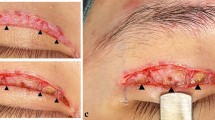Abstract
Background
In recent years, because the formation mechanism of double eyelids in Asians is still controversial, many techniques for double-eyelid plasty have been developed. However, the removal of large amounts of pretarsal tissue and the obvious scars in those techniques make patients dissatisfied with the appearance. Thus, we have devised a novel surgical approach named the kiss technique. The method is to create a physiological double-eyelid fold on the basis of the formation mechanism of double-eyelid creases.
Methods
From January 2017 to March 2019, the novel blepharoplasty was performed on 386 Chinese patients (769 eyes) in our department. Patients were evaluated at 3–24 months after surgery. Instead of dividing the orbital septum all the way to the orbital margin both medially and laterally, all that is required is to dissect the pretarsal orbicularis oculi muscle inferiorly to the lower border of the tarsus and to incise the pretarsal extension of the aponeurosis to expose the white line. Then, the white line is sutured to the orbicularis oculi muscle. Finally, the skin incisions are sutured interruptedly, and a vivid fold is created.
Results
The general satisfaction rate was 97.5%. The edema period for most patients ended within 2 weeks. The scars became unnoticeable after 3–6 months. Disappearance of the fold was not found in any case.
Conclusions
The kiss technique is a simple and effective method, which can not only create a natural double crease but also reduce the complications of double-eyelid surgery.
Level of Evidence IV
This journal requires that authors assign a level of evidence to each article. For a full description of these Evidence-Based Medicine ratings, please refer to the Table of Contents or the online Instructions to Authors www.springer.com/00266.
















Similar content being viewed by others
References
Chen WP (2013) Asian upper lid blepharoplasty: an update on indications and technique. Facial Plast Surg 29:26–31. https://doi.org/10.1055/s-0033-1333832
Megumi Y (1997) Double-eyelid procedure by removal of transconjunctival orbital fat and buried sutures combined with sling technique to avoid wounding the eyelid. Aesthet Plast Surg. 21:254–257
Liao WC, Tung TC, Tsai TR et al (2005) Celebrity arcade suture blepharoplasty for double-eyelid. Aesthet Plast Surg. 29:540–545
McCurdy JA (2002) Upper blepharoplasty in the Asian patient: the “double eyelid” operation. Facial Plast Surg Clin North Am 10:351–368
Miyake I, Tange I (1994) MRI findings of the upper eyelid and their relationship with single- and double-eyelid formation. Aesthet Plast Surg 18:183–187
Pan E, Nie YF, Wang ZJ et al (2016) Aponeurosis of the levator palpebrae superioris in Chinese subjects: a live gross anatomy and cadaveric histological study. Medicine (Baltimore) 95:e4469. https://doi.org/10.1097/MD.0000000000004469
Kakizaki H, Leibovitch I, Selva D et al (2009) Orbital septum attachment on the levator aponeurosis in Asians: in vivo and cadaver study. Ophthalmology 116:2031–2035. https://doi.org/10.1016/j.ophtha.2009.04.005
Zuo L, Yu J, Zhou X et al (2018) Application of free anterolateral thigh Kiss flap in repair of large scalp defect after malignant tumor resection. Zhongguo Xiu Fu Chong Jian Wai Ke Za Zhi 32:346–349. https://doi.org/10.7507/1002-1892.201711046
Li FC (2008) Double eyelid blepharoplasty incorporating epicanthoplasty using Y-V advancement procedure. J Plast Reconstr Aesthet Surg 61:901–905. https://doi.org/10.1016/j.bjps.2007.05.008
Li G, Ding W, Tan J et al (2018) A new method for double-eyelid blepharoplasty using orbital septum. Ann Plast Surg 81:633–636. https://doi.org/10.1097/SAP.0000000000001650
Sayoc BT (1956) Absence of superior palpebral fold in slit eyes; an anatomic and physiologic explanation. Am J Ophthalmol 42:298–300
Sayoc BT (1954) Plastic construction of the superior palpebral fold. Am J Ophthalmol 38:556–559
Park JI (1999) Orbicularis-levator fixation in double-eyelid operation. Arch Facial Plast Surg 1:90–95. (discussion 96)
Reid RR, Said HK, Yu M et al (2006) Revisiting upper eyelid anatomy: introduction of the septal extension. Plast Reconstr Surg 117:65–66. (discussion 71-2)
Author information
Authors and Affiliations
Corresponding author
Ethics declarations
Conflict of interest
No potential conflict of interest was reported by the authors.
Ethical Approval
All procedures performed in studies involving human participants were in accordance with the ethical standards of the institutional and/or national research committee and with the 1964 Helsinki Declaration and its later amendments or comparable ethical standards.
Informed Consent
For this type of study, informed consent is not required.
Additional information
Publisher's Note
Springer Nature remains neutral with regard to jurisdictional claims in published maps and institutional affiliations.
Rights and permissions
About this article
Cite this article
Zhou, X., Wang, H. Orbicularis–White Line Fixation in Asian Blepharoplasty: Kiss Technique. Aesth Plast Surg 43, 1553–1560 (2019). https://doi.org/10.1007/s00266-019-01454-x
Received:
Accepted:
Published:
Issue Date:
DOI: https://doi.org/10.1007/s00266-019-01454-x




